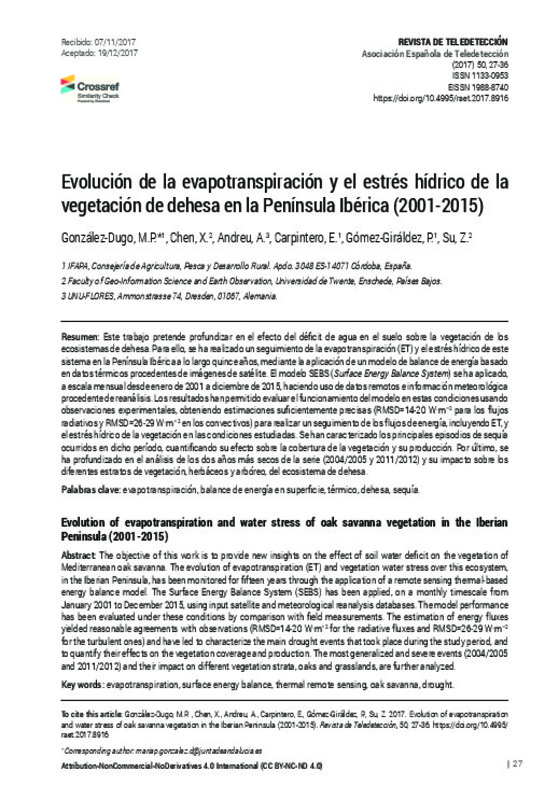JavaScript is disabled for your browser. Some features of this site may not work without it.
Buscar en RiuNet
Listar
Mi cuenta
Estadísticas
Ayuda RiuNet
Admin. UPV
Evolución de la evapotranspiración y el estrés hídrico de la vegetación de dehesa en la Península Ibérica (2001-2015)
Mostrar el registro completo del ítem
González-Dugo, MP.; Chen, X.; Andreu, A.; Carpintero, E.; Gómez-Giráldez, P.; Su, Z. (2017). Evolución de la evapotranspiración y el estrés hídrico de la vegetación de dehesa en la Península Ibérica (2001-2015). Revista de Teledetección. (50):27-36. https://doi.org/10.4995/raet.2017.8916
Por favor, use este identificador para citar o enlazar este ítem: http://hdl.handle.net/10251/93824
Ficheros en el ítem
Metadatos del ítem
| Título: | Evolución de la evapotranspiración y el estrés hídrico de la vegetación de dehesa en la Península Ibérica (2001-2015) | |
| Otro titulo: |
|
|
| Autor: | González-Dugo, M. P. Chen, X. Andreu, A. Carpintero, E. Gómez-Giráldez, P. Su, Z. | |
| Fecha difusión: |
|
|
| Resumen: |
[EN] The objective of this work is to provide new insights about the effect of soil water deficit on the vegetation of Mediterranean oak savanna. The evolution of evapotranspiration (ET) and vegetation water stress over ...[+]
[ES] Este trabajo pretende profundizar en el efecto del déficit de agua en el suelo sobre la vegetación de los ecosistemas de dehesa. Para ello, se ha realizado un seguimiento de la evapotranspiración (ET) y el estrés ...[+]
|
|
| Palabras clave: |
|
|
| Derechos de uso: | Reconocimiento - No comercial - Sin obra derivada (by-nc-nd) | |
| Fuente: |
|
|
| DOI: |
|
|
| Editorial: |
|
|
| Versión del editor: | https://doi.org/10.4995/raet.2017.8916 | |
| Código del Proyecto: |
|
|
| Agradecimientos: |
Los autores desean agradecer la financiación re-cibida de INIA y FEDER 2014-2020 (Programa operativo de crecimiento inteligente) mediante el proyecto RTA2014-00063-C04-02, y del Co-operative Research Programme (CRP): ...[+]
|
|
| Tipo: |
|








